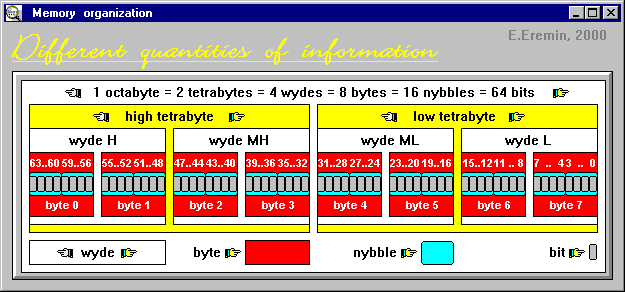
|
Basics
|
|
|
MMIX can work with 64, 32, 16 and 8-bit data. Its memory has byte organization and so every byte has its own address. Hence it's no wonder that the difference between the addresses of two consequent bytes is equal to 1. Being a 64-bit computer, MMIX can address
Although MMIX can't read from its memory less than 1 byte, this is not minimum amount of information. Every byte consists from 8 bit, conventionally grouped into two 4-bit halfs called nybbles. Consecutive bytes in computer's memory can be united into several quantities of information, which also have special names. Here is the full list of units, which can be used as a measure of information quantities:

Basic information unit in modern computers is byte (red rectangles in the picture). Two basic ways of byte's numeration are usually used. In MMIX the most significant byte has the lowest address (so-called "big endian" way). Pairs of bytes can be combined into wydes. In MMIX every wyde has its definition: H, MH, ML and L - see the above picture. 32 bits (4 bytes) form tetrabyte or simply tetra. Tetra is a half of the memory cell in MMIX. Note that every processor instruction occupies 1 tetra. And at last all 64-bit cell is called octabyte or simply octa. Related topics: |
|
| (C) 2001, Evgeny Eremin. rEd-MMI project documentation | |